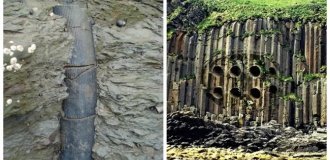Electronic intelligence station "Kolchuga"

After a rather loud “advertising campaign” organized by the US State Department, the Ukrainian radio intelligence station “Kolchuga” produced by the State Joint Stock Holding Company “Topaz” is known to many.
But what do we know about her?
Dedicated to Air Defense Day
What scared the Americans so much?

The version about the righteous indignation of the Americans, who piously respect the basic institutions of international law, regarding a possible violation by a Ukrainian enterprise of UN Security Council sanctions regarding Iraq, of course, has a right to exist. Nevertheless, another version can be considered more probable, which is based precisely on the uniqueness of a high-tech Ukrainian product, whose characteristic Old Slavonic name is already well known not only by specialists and not only in Ukraine.
In short, domestic scientific, technical and design solutions in the field of passive radar, technologically implemented in the equipment of the Kolchuga electronic intelligence complex, are what, figuratively speaking, do not allow developers and relevant government functionaries responsible for implementation in modern samples of stealth technology weapons. That is, technologies aimed at realizing the cherished dream of all generals - to make their planes, ships, tanks and other types of military equipment “invisible” to the enemy’s technical means. Nevertheless, you can change the shape of any type of military equipment as much as you like (as, for example, this is done in the American F-117 and B-2 aircraft), so that the signal from the active enemy radar reflected from it is scattered in different directions, practically without returning in the opposite direction , or apply various absorbing coatings to this sample so that the energy of the same signal is converted into heat, but not a single sample of modern military equipment can fundamentally exist without its own radar. Without an antenna that operates on radiation, he is, figuratively speaking, “blind”, at least not capable of performing combat missions as intended. Therefore, there is always active radar equipment on board every ship, aircraft, as well as as part of ground-based systems. During combat missions, these means are required to operate and emit radio signals. Moreover, for each type of military equipment, such signals differ in their parameters from the signals of other types of military equipment, and therefore, the combat vehicle on which the emitted radar is installed can be recognized.

Usually, from the abstract formulation of a scientific-theoretical possibility to its concrete practical embodiment directly in “metal”, the distance is huge, sometimes even insurmountable. In order to pass it, that is, carry out scientific research, develop appropriate algorithms, repeatedly test technical and technological solutions on research samples, and also establish mass production, specialists from OJSC "Special Design Bureau of Radio Engineering Devices", OJSC "Topaz", Donetsk National Technical University, it took the state company "Ukrspetsexport" and the "Investment and Technology Company" eight years (1993-2000). The result led to the emergence of a qualitatively new situation in the fundamental confrontation for the information advantage, which is especially valuable in modern conditions, between strategic means of attack and defense, which continues constantly, if not directly on the battlefields, then at least between the corresponding leading research and development institutions of the modern world. Relatively inexpensive Ukrainian electronic intelligence station "Kolchuga", which is mass-produced by the State Joint Stock Holding Company (JSC) "Topaz" and is capable of detecting and recognizing almost all active radio equipment known at that time, installed on ground, sea and air objects, practically negating all those multi-billion-dollar funds that were and are being spent on creating weapons using stealth technologies.
After the US military operation in Iraq in 1991, when the qualitatively new F-117 stealth fighters, built using stealth technologies, were first used in combat operations, it seemed to many that in the confrontation between air attack and air defense (air defense) weapons, the final winner was eventually determined. Having carried out 1272 sorties, these American aircraft had one hundred percent (!) survival rate, destroying about 40% of high-priority ground targets in areas with dense Iraqi air defense. At the same time, the success of American air offensive operations was ensured mainly, which is typical, not by overcoming, but by suppressing the enemy’s air defense system. To do this, radar stations operating in active mode were first detected (this is quite easy, given their powerful radiation), after which appropriate weapons were used against them, of which there are more than enough in the modern arsenal of weapons. That is, air defense systems built on the basis of only active radar were in fact only capable of confirming the presence of a massive air raid, because the attacking side destroyed them already in the first hours after the start of hostilities.
The creation in young independent Ukraine, which was then making great efforts to emerge from a large-scale systemic economic crisis, of a modern passive electronic reconnaissance station "Kolchuga" became for the Americans, confident in the guaranteed conquest and maintenance of superiority in the air thanks to the most modern "invisible" aircraft, more than a fundamental scientific, technical and technological defeat. On the one hand, the advantages of the “invisibility” of the attacking side were completely eliminated, and on the other hand, thanks to the use of the principle of passive location, that is, the absence of its own radiation, the above-mentioned disadvantage of insufficient secrecy of the main source of obtaining information from the defending side was radically eliminated. In addition, an attacking object detected by a passive radar in no way can learn about the very fact of its detection, and therefore, it has no reason to apply measures of its own protection. That is, the information advantage that is especially significant in modern combat operations thus turned out to be on the defending side.
In addition, the tactical and technical characteristics of the latest modification of the Ukrainian electronic intelligence station are truly impressive for the relevant specialists:

- a complex of three Kolchuga stations allows you to determine the coordinates of ground and surface targets and their routes of movement in an area up to 600 km in depth (for air targets at an altitude of 10 km - up to 800 km) and up to 1000 km along the front, which makes it possible to implement, in particular, early warning of the country's air defense systems;
- the station has five antenna systems in the meter, decimeter and centimeter ranges, ensuring the sensitivity of the radio path in the panoramic viewing band from -110 to -155 dB/W, depending on the frequency;
- a parallel 36-channel detection receiver allows instant frequency-free detection, analysis and classification of signals from radio emission sources without limiting the input flux density over the entire frequency range from 130 to 18,000 MHz;
- the station performs all operations to detect and recognize radio emission sources fully automatically, while a powerful on-board computer carries out analysis and numerical processing, as well as recognition of detected targets by comparing their parameters with a data bank, and the results are displayed on a monitor with a map of the area;
- special interfering selectors allow you to exclude up to 24 interfering signals from the corresponding processing, and tracking selectors allow you to synchronously select and track signals from 32 targets;
- to perform all the main tasks of the station in normal mode, only one operator is needed (the other two are included in the crew to ensure round-the-clock operation), who controls the operation of the station in interactive mode with a personal computer.

Since the non-nuclear power of the United States is actually based on military equipment built using stealth technologies, the strategic interests of the latter were absolutely not met by the prospect of, figuratively speaking, the “spreading” of unique Ukrainian radio-technical intelligence stations “Kolchuga” around the world. The first demonstration of the export version of the latter took place at the SOFEX-2000 arms exhibition in Jordan. Therefore, it was precisely this—actually American—interest that became, apparently, the most significant catalyst for the so-called “chain mail” scandal.
Such a promising area as passive radar, of course, could not fail to attract the attention of technologically developed countries. But a complete analogue of the Ukrainian passive electronic reconnaissance station “Kolchuga” in terms of the totality of operational and technical characteristics (and this can be stated absolutely unequivocally) does not exist in the world. In terms of basic parameters, it surpasses all known methods for a similar or similar purpose.

The detection range of air targets of 800 km was achieved only by the Ukrainian Kolchuga. The closest to it in terms of these indicators is the American air-based Avax, which provides such a range only at the level of 600 km, and the ground-based Vera (Czech Republic) and Vega (Russia) complexes - 400 km, that is, half as much as the Ukrainian product. The lower limit of the operating frequency range in which targets are detected, for the Kolchuga - 130 MHz, is the smallest among its analogues: Avaxa - 2,000 MHz, Vera - 850 MHz, Vega - 200 MHz.
The Kolchuga has its greatest advantages in those characteristics on which the reliable recognition of detected targets depends. This is ensured both by the uniqueness of the corresponding algorithms incorporated during the development, and by their high-tech hardware implementation, achieved during mass production. In particular, the standard deviation of frequency measurements - the most informative parameters for determining the types of detected radar stations - is 0.4 MHz for the Kolchuga, while for the Russian Vega it is 0.5-1.0 MHz, and for the American Avaxa" - 1.0 MHz, and the Czech "Vera" generally has 3.6-21.0 MHz. The maximum duration of detected pulses measured by Kolchuga is 999.0 μs, compared to 99.9 μs for Avax and 200 μs for Vera. The repetition period of such pulses can be measured by “Kolchuga” up to a maximum value of 79,999 μs, while analogues are capable of carrying out such measurements only up to a maximum value of 10,000 μs. As a result, the number of radio equipment that are classified upon detection is practically unlimited for the Kolchuga, which cannot be said about any of the known analogues. The Ukrainian station algorithmically and programmatically provides for the analysis, systematization, generalization and storage in a database of information about all detected sources of radio emission and the parameters of the signals emitted by them. The information collected in the specified database can be used to identify and recognize newly discovered sources of radio emission, as well as for generalization in context with information obtained by other intelligence channels.

It should also be noted that the irrefutable advantages of the Ukrainian “Kolchuga” are not accidental or fleeting. Neither American, nor Russian, nor French, nor Czech, nor Brazilian developments in this area are able to compare with the current mass-produced Ukrainian product. And the Ukrainian scientists and designers involved in the creation of this unique product are by no means “resting on their laurels,” of which, by the way, there are still not many, thereby increasing their “gap” from their main competitors.
Already implemented export contracts for the supply of Kolchuga complexes do not fully reflect the powerful export potential of this Ukrainian product, which has already attracted numerous buyers from near and far abroad.
Ukraine’s entry, for the first time since its independence, into the world market of knowledge-intensive and high-tech radio-electronic products with its own development, successfully introduced into mass production, which, moreover, has no analogues in its characteristics, is clear evidence of outstanding positive trends in the development of the Ukrainian high-tech complex. At the same time, an analysis of those purely internal factors thanks to which this symptomatic “breakthrough” was achieved allows us to identify the main components necessary for the spread and consolidation of such very optimistic trends in modern Ukraine.
Particularly noteworthy is the close connection between the production enterprise Topaz OJSC and the Topaz State Chemical Company established in 1996 with domestic scientists, in particular with the Donetsk National Technical University. Quite significant material support from the holding company of this higher educational institution not only stimulated intensive theoretical research in the field of passive radar and information visualization and display systems, but also had such a significant result as ensuring the training of fairly qualified specialists for JSC Topaz and the Special Design Bureau radio engineering devices". The latter is part of the holding and, unlike most current Ukrainian research institutions (having “lost” their personnel, they now stay afloat mainly by leasing their space), has increased its number by four since 1996 times. Consequently, the corresponding scientific school was not only preserved, but also expanded the areas of application of its efforts.

Taking into account the above, it should be stated: the investments of the state company "Ukrspetsexport" and the credit resources of Prominvestbank allocated for the creation of the Kolchuga passive electronic reconnaissance complex and its introduction into mass production fell on quite fertile ground, and the managers of these enterprises, who made innovative investments, demonstrated their foresight. When organizationally supported and financially motivated scientists set to work for their main purpose, the results, as they say, were not long in coming.
In the course of painstaking, long-term and persistent work on the development and introduction into mass production of the Kolchuga complex, numerous scientific, technical, design and technological problems were set and solved, and high-tech production facilities were created for the manufacture of modern elemental base for high-frequency radio electronics, ultra-high frequency technology, antenna mirrors and other components, which together provided unsurpassed characteristics of a unique in design and high-tech in execution Ukrainian product. The novelty of the technical solutions used in the Kolchuga complex is protected by eight patents, and its mass production is protected by 12 technological know-how.
The steady demand of the external market for the Kolchuga electronic intelligence systems, mass-produced by the Topaz State Chemical Company, allowed not only to save jobs and relevant specialists, but also, based on the achieved level of financial and economic status, to provide further financing for new promising developments. After all, appetite, as people aptly say, comes with eating. Feeling a taste of the achieved leadership in the field of passive radar, Ukrainian specialists set about fundamentally improving the Mandat counter-communications complex, which during Soviet times was the main product of the Donetsk Topaz. The new development should also be ahead of world analogues.
Using the developments embodied in the latest modification of the Kolchuga, GAKhK Topaz also carries out work on the repair and modernization of passive electronic reconnaissance equipment in service with the Ukrainian army. And this, in turn, allows the Armed Forces of Ukraine to meet the relevant needs regarding the tactical and technical capabilities of this equipment without significant expenses from the defense budget. That is, the scientific, technical and technological breakthrough carried out in the domestic defense industry provided, as it should, not only the financial basis for the existence of the production enterprise itself and further scientific research, but also a corresponding contribution to strengthening the defense capability of the state.
It is also symptomatic that the Donetsk tandem - a manufacturing enterprise + design bureau - with the support of a Ukrainian special exporter and a domestic bank, has become a kind of “growth pole” in the radio-electronic sector, as well as related sectors. The successful activities of the State Chemical Holding Company "Topaz" guaranteed significant support, in particular, from such Ukrainian manufacturers as "Iskra" (Zaporozhye), "Saturn" (Kiev), "Orion" (Smela), "Elsis" (Kiev). Poltava), "Generator" (Kiev) and "KrAZ" (Kremenchug).

The production of all high-tech products in the world is now ensured by approximately 50 macrotechnologies. At the same time, the seven most developed countries, owning 46 macro-technologies, hold approximately 80% of the highly profitable market for high-tech products. The share of the price of these products belongs to labor costs, which, of course, has a positive effect on the living standards of the population in these countries.
The fact that Ukrainian scientists, designers and engineers were able to enter the world market of knowledge-intensive, high-tech products with their product - the new generation of strategic long-range electronic reconnaissance complex "Kolchuga", surpassing all foreign analogues - inspires a certain optimism about the future place of Ukraine in the international division of labor. After all, any, even the most successful, market transformations that are not supported by technological breakthroughs cannot become the cause of the so-called economic miracle. “Kolchuga” became confirmation that after a long period of sailing on the stormy sea of economic cataclysms, the scientific and technical potential existing in Ukraine finally began to be realized into specific, knowledge-intensive high-tech products in demand on the world market, with corresponding economic returns.
And it is quite logical that the State Prize in the field of science and technology will be awarded to pioneers on this thorny path, who, in extremely difficult economic conditions (let me remind you again - 1993-2000!) were not only able to preserve the scientific school and technological potential, but also received a very specific result, now known throughout the world, in the form of a unique electronic intelligence complex “Kolchuga”.





















